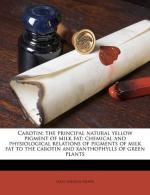|
This section contains 320 words (approx. 2 pages at 300 words per page) |
Photosynthesis is the conversion of light energy into chemical energy utilized by plants, many algae, and cyanobacteria. However, each photosynthetic organism must be able to dissipate the light radiation that exceeds its capacity for carbon dioxide fixation before it can damage the photosynthetic apparatus (i.e., the chloroplast). This photoprotection is usually mediated by oxygenated carotenoids, i.e., a group of yellow pigments termed xanthophylls, including violaxanthin, antheraxanthin, and zeaxanthin, which dissipate the thermal radiation from the sunlight through the xanthophyll cycle.
Xanthophylls are present in two large protein-cofactor complexes, present in photosynthetic membranes of organisms using Photosystem I or Photosystem II. Photosystem II uses water as electron donors, and pigments and quinones as electron acceptors, whereas the Photosystem I uses plastocyanin as electron donors and iron-sulphur centers as electron acceptors. Photosystem I in thermophilic Cyanobacteria, for instance, is a crystal structure that contains 12 protein subunits, two phylloquinones, 22 carotenoids, 127 cofactors constituting 96 chlorophylls, besides calcium cations, phospholipids, three iron-sulphur groups, water, and other elements. This apparatus captures light and transfers electrons to pigments and at the same time dissipates the excessive excitation energy via the xanthophylls.
Xanthophylls are synthesized inside the plastids and do not depend on light for their synthesis as do chlorophylls. From dawn to sunset, plants and other photosynthetic organisms are exposed to different amounts of solar radiation, which determine the xanthophyll cycle. At dawn, a pool of diepoxides termed violaxanthin is found in the plastids, which will be converted by the monoepoxide antheraxanthin into zeaxanthin as the light intensity gradually increases during the day. Zeaxanthin absorbs and dissipates the excessive solar radiation that is not used by chlorophyll during carbon dioxide fixation. At the peak hours of sunlight exposition, almost all xanthophyll in the pool is found under the form of zeaxanthin, which will be gradually reconverted into violaxanthin as the solar radiation decreases in the afternoon to be reused again in the next day.
|
This section contains 320 words (approx. 2 pages at 300 words per page) |


